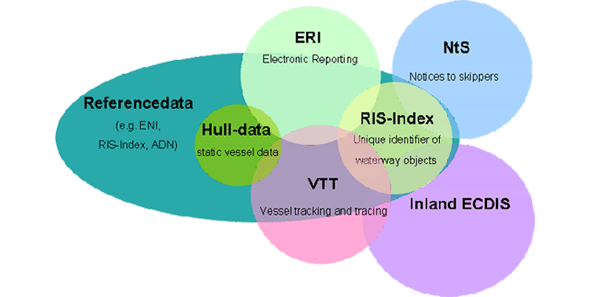RIS technologies
Systems for the technical and operational implementation of RIS
Various systems are available for the technical and operational implementation of a River Information Service as specified in the Guidelines and Recommendations for River Information Services (RIS Guidelines):
- Visual aids to navigation
- Radar-reflecting aids to navigation
- Light signals
- Mobile phone (voice and data, e.g. for fax, text messages)
- GNSS (Global Navigation Satellite System) for vessel positioning
- VHF radiotelephone
- Internet (e-mail, obtaining information)
- Vessel-based radar
- Shore-based radar
- Shore-based CCTV cameras (closed circuit television, i.e. surveillance cameras)
- Electronic navigational chart service (i.e. Inland ECDIS with IENC)
- Vessel tracking and tracing system (Inland AIS)
- Ship reporting system (electronic reporting).
The electronic systems used to communicate messages for inland navigation have recently come to be referred to as RIS technologies.

Basic RIS technologies
The systems that will probably continue to be the most important for implementing RIS are
- Radiotelephone and
- Radar.

Key RIS technologies
Key RIS technologies play a crucial role in those River Information Services which are currently made available. The key RIS technologies are:

RIS reference data
Efficient and effective use of the key RIS technologies relies on the specification, codification, formalisation and harmonised use of reference data. The most important reference data are the vessel data and the RIS Index.
The data for identifying a vessel (hull data) are listed in annex P of the Rhine Vessel Inspection Regulations (RVIR). Article 2.18 of the RVIR specifies how the vessel data are to be generated and used. The central component of the vessel data is the unique European vessel identification number (ENI).
For the purpose of localisation, the data used to identify waterway objects are based on unique codes. The RIS Index is a list of such codes with additional information on the particular objects, such as the name, and including any restricting conditions (e.g. vertical clearance) and other items of information.



